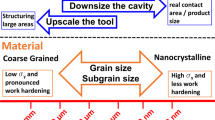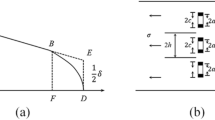Abstract
To examine experimentally the influence of head-tip morphology on electrical and mechanical properties at the contact with a phosphor bronze, cantilever-type microconnectors of Ni–Co alloys were prepared by an electroplating technique. Here, the mol fraction y of Co in the Ni–Co alloy is 0.178, 0.204, 0.233 and 0.299. Among these alloys, the Vickers hardness is H V = 510, 518, 525 and 478 for y = 0.178, 0.204, 0.233 and 0.299, respectively. Since the Vickers hardness is the maximum for y = 0.233, the Ni–0.233Co alloy may indicate the best wear-resistance. The loading and unloading manipulations were repeated to measure electrical resistance at the mechanical contact between the Ni–0.233Co microconnector and the phosphor bronze up to 103 times. The repetitive measurement was conducted for microconnectors with thickness of 45 μm and head-tip curvature radii of r = 5, 25, 50 and 200 μm. Even at the initial repetition, the reliable electrical contact is actualized for r = 5 μm but not for r = 25–200 μm. The experimental result was quantitatively analyzed using a mechanical model. The analysis provides that the impression depth z of the head-tip into the phosphor bronze at the contact is mostly inversely proportional to r for r ≥ 5 μm. When r is measured in mm, the proportionality coefficient is 6 × 10−7 mm2. As a consequence, the most reliable electrical contact of the Ni–Co microconnector with r = 5 μm is ascribable to the largest impression depth of the head-tip into the phosphor bronze.









Similar content being viewed by others
References
JIS Handbook, Japanese Standards Association, Vol. 3 Tokyo, (2011) p. 535
T. Unno, T. Toriyama, M.M.I. Bhuiyan, Y. Yokoyama, S. Sugiyama, Trans Inst Electrical Eng Japan 122-E, (2002) p. 249
Y. Isono, J. Tada, T. Watanabe, T. Unno, T. Toriyama, S. Sugiyama, Proc 12th Int Conf Solid-state Sensors and Actuators, Vol. 1 (Springer, Berlin, 2003), p. 456
T. Unno, M.M.I. Bhuiyan, Y. Yokoyama, T. Toriyama, S. Sugiyama, Abst Technical Digest of 17th Sensor Symposium, Kawasaki, (2000)
Y. Yokoyama, M.M.I. Bhuiyan, T. Unno, T. Toriyama, S. Sugiyama, IEEJ Trans Sensors Micromachines, Tokyo, (2000) p. 57
T. Unno, T. Toriyama, M.M.I. Bhuiyan, Y. Yokoyama, S. Sugiyama, Proc 18th Sensor Symposium 2001 (Inst Electrical Eng Japan, Tokyo, 2001), p. 165
Y. Isono, J. Tada, T. Watanabe, T. Unno, T. Toriyama, S. Sugiyama, Trans 12th Int Conf Solid-slate Sensors, Actuators and Microsystems (Boston, 2003)
T.B. Massalski, H. Okamoto, P.R. Subramanian, L. Kacprzak, Binary alloy phase diagrams, vol. 2 (ASM International, Materials Park, Ohio, 1990), p. 1215
G.E. Dieter, Mechanical Metallurgy (McGraw-Hill Book Co, New York, 1988), p. 325
Acknowledgments
The authors are grateful to Messrs. K. Sakamoto, N. Kurokawa and E. Takemasa at Tyco Electronics AMP Co. Ltd., Japan for stimulating discussions. The present study was supported by Tyco Electronics AMP Co. Ltd., Japan. The study was also partially supported by a Grant-in-Aid for Scientific Research from the Ministry of Education, Culture, Sports, Science and Technology of Japan.
Author information
Authors and Affiliations
Corresponding author
Rights and permissions
About this article
Cite this article
Bhuiyan, M.M.I., Quadri, H.A., Bhuiyan, M. et al. Influence of head-tip morphology on contact properties for microconnector of Ni–Co alloy. J Mater Sci: Mater Electron 24, 3175–3182 (2013). https://doi.org/10.1007/s10854-013-1224-0
Received:
Accepted:
Published:
Issue Date:
DOI: https://doi.org/10.1007/s10854-013-1224-0




